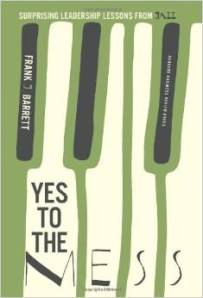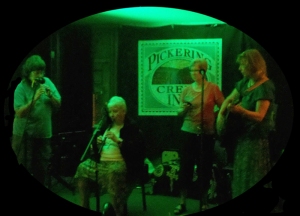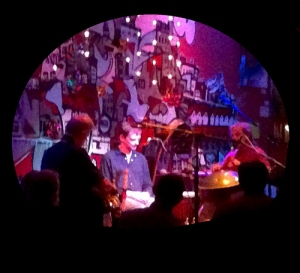Jamming.
When I was to be an invited flutemaker for Flute Haven in September 2014, I thought about what a great learning experience I had when I attended the Flute Haven Leadership Training.
That made me think about jamming.
One of our activities during the week was learning to improvise – both how to work in a flute group that is improvising and how to adopt an outlook that can embrace innovation.
 I am reminded of Frank J. Barrett’s book Yes to the Mess: Surprising Leadership Lessons from Jazz (2012).
I am reminded of Frank J. Barrett’s book Yes to the Mess: Surprising Leadership Lessons from Jazz (2012).
Barrett is a professor of management of global public policy at the Naval Postgraduate School in Monterey, Calif., and also is a jazz pianist. His book ties together the processes involved with the improvisation of jazz with using those techniques in business management.
Here are some of his thoughts that struck a chord with me as a flute player.
Many of us who are playing flute now played other musical instruments earlier in our lives – playing in the school band or playing the guitar or piano.
One of the ways we demonstrated we could play music was being able to play recognizable sounds and songs. That ability legitimized you as a musician.
But some flute playing can be developing a song as you play. Instead of rehearsing a song, as you did for the choir or the band, you arrive at flute circle open to the opportunity to play in the moment. Someone else plays a riff, and you take the lead from that.
Improvisation gives you permission to experiment.
Improvisation validates a number of different techniques. You hear people try things – perhaps rubbing their fingers across the flute’s holes rather than holding down individual notes – and see how those improvisations can work.
Barrett tells of a time when he played in a jazz quartet with players and a singer he had never played with. During one of the songs, the singer forgot the words to the song. The other three musicians stopped playing because something was amiss. But Barrett kept playing. The other musicians joined back in, and the singer joined in, making up words as they went along.

So rather than getting caught up in the idea that there’s only one way to play a song, by jamming, we can see a variety of approaches. Every song will be fresh because you don’t have to follow a prescribed set of notes.
Another chapter was on “Taking Turns Soloing and Supporting: Followership as a Noble Calling.” Barrett says, “Jazz thrives on improvisation; there’s no clear road map that tells people how to act in order to coordinate with one another. The only route available to them, in fact, is listening.”
Barrett says that jazz greats can be “generous listeners,” being able to hear what others are doing and find what’s positive about it. Barrett said jazz legend Miles Davis said he was able to improvise by listening to everyone is playing and then play what is missing.
Flute circles can provide a great opportunity for generous listening and then being able to share who is soloing and who is supporting. A different approach than playing in the school band where everyone played their determined part and counted on the band conductor to make sure the different instruments and parts came together.
“What made the learning process even richer was the hangout out afterward,” Barrett says in his chapter “Jamming and Hanging Out.” Barrett said that those hanging out sessions after the jamming – often over a meal or drinks — provided the opportunity for the musicians to talk about “harmonic changes, the rhythmic displacements, the inspiring moments, the songs on which we connected and the times when we didn’t connect, and on and on.”

Hanging out, as he calls it, provides the time to reflect on what happened while jamming and to see what the different perspectives were of the musicians who participated.
We did quite a bit of “hanging out” at Flute Haven. After performing at local restaurants we often would stay up for late-night jam sessions. Not only could we talk about what worked and what didn’t, but we could provide feedback. That was a real confidence booster.
In Say Yes to the Mess: Surprising Lessons from Jazz, published by the Harvard Business Review Press, Barrett took those jazz experiences and connected them to the business world.
- Be attuned to what others are saying and doing and note how you can recognize their efforts and adapt your efforts to work with them.
- Be open to improvising and being able to continue on even when you don’t have clear guidelines and aren’t sure how the process is going.
- Take time to debrief with colleagues – celebrating accomplishments and determining what’s not working and how that can be improved.
These are all good lessons for flute players and are principles that can translate into other areas of our lives.
[…] blog, Wren Song: Flutes and Kanteles, includes a recent post on improvisation and innovation that offers good advice. Judy’s tips refer specifically to jamming with musicians, but the experiences can be readily […]
LikeLike
Hi Kay — isn’t that the truth about the universality of the principles. I know you are one for innovation yourself! Certainly I would be delighted (and honored) to have you share and connect.
LikeLike
John, Perhaps you could contact the people in the other Michigan circles (listed at http://www.worldflutes.org/flute_circles_clubs_and_groups/) and they might be able to tell you of some folks they know in Kalamazoo. You could start your own flute circle. You only need 2 or 3 to start. I’d be happy to share some activities that you could try in your flute circle too! I understand the frustration. I hope to revive our Gainesville flute circle this Fall.
LikeLike
Those principles and suggestions shared can be used in so many areas of our lives. Thanks for touting improvisation and innovation and applying them to more than one part of our lives in this post! May I borrow and connect (and attribute) those experiences in a piece for Mentoring Matters too?
LikeLike
I wish there was a flute circle around here (Kalamazoo, MI). So many possibilities missing.
LikeLike